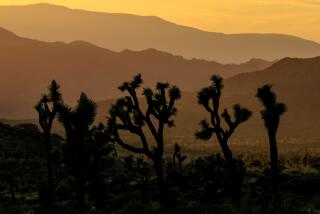Joshua Trees : Celebrating a ‘Curious Looking Plant...’
In the high desert, the Joshua tree is among the most prominent and enduring forms of native vegetation. Large specimens average 30 feet tall, with one giant in Lancaster measured at 58 feet and estimated to be 1,000 years old.
In some areas of the Antelope Valley, where many residents are fond of the gawky trees, they can be found in dense clusters spread over several acres.
Joshua trees thrive in arid regions of Southern California, Arizona, Nevada and Utah, generally at elevations of 2,000 to 6,000 feet.
The Joshua tree is not a cactus, but is actually a member of the lily family.
They have been called “the most imposing yuccas in the Southwest and rank with the giant cactus (saguaro) as a symbol of the desert,” according to a U.S. Department of Agriculture researcher.
Early Encounters
The name for the desert tree is believed to have come from Mormons traveling to Utah in the mid 1800s. The Joshua tree’s “rigid, angular, grotesquely pointing branches struck the imagination of the Mormons who likened the trees to Joshua pointing the way and leading them to the promised land,” an author wrote in a 1938 book on California plants.
Some have seen Joshuas as the splendor of the desert - tall and stately, each one unique. Others have found them grotesque.
One of the first references to the plant was by the explorer, Lt. John C. Fremont, who was definitely among the latter group. In 1844 he wrote that the Joshua tree “gave a strange and southern character to the country .... Associated with the idea of barren sands, their stiff and ungraceful form makes them to the traveler the most repulsive tree in the vegetable kingdom.”
A century later, a writer said, “It is indeed a curious looking plant, suggesting, in its oldest forms especially, another age; one would not be surprised to see a huge prehistoric monster standing by and feeding upon the fruit on its upper branches....”
Preservation Efforts
As many as 200,000 Joshua trees in the Antelope Valley were bulldozed and discarded in landfills during the residential development boom in the mid- to late-1980s.
Community-based efforts to ensure the continued existence of the Joshua tree in north Los Angeles County have had mixed results, with some saying the protection has come too late.
In Palmdale, a two-year-old ordinance requires that a minimum of two Joshua trees per acre be preserved on land proposed for development. The measure, which also applies to other native vegetation such as California junipers, allows developers additional destruction, but only as a last result and on payment of a fee of $200 per tree.
Lancaster’s efforts to preserve Joshua trees date back to 1980. The city has designated four vegetation management districts, totaling about 2,200 acres. Developers who want to build within the districts must pay a fee of $6,200 to $7,500 per acre, based on the quality of the native vegetation on the site. The money the city collects is to be used for the purchase of a 90-acre prime desert woodland, about half of which the city now owns. The fee provisions were adopted in 1991.
In unincorporated areas of Los Angeles County, Joshua trees lack protection except for a small tract west of Lancaster that has been designated as a significant ecological area. Any development proposals there are subject to a more stringent review.
Several years ago, county planners drafted an ordinance that would have provided some protection to Joshua trees, but it was never enacted.
Their Desert Environment
With its stiff, lance-like leaves, the Joshua forms branches for the first time after producing its greenish-white flower clusters. Once a branch flowers, it does not continue to grow from the end but instead sends off a side branch. This process continues over the years to produce the tree-like top seen on the most stunning Joshua trees.
Besides propagating from seed, Joshua trees spread by underground stems that sprout a short distance from the parent tree.
To animals, Joshua trees are an important part of the desert environment. Lizards, rodents and birds seek shelter in the spiny trees. There is a variety of a butterfly as well as a moth, which pollinates the tree and lays eggs on the Joshua. The fruit of the Joshua tree is eaten by birds and rodents.
Commercial Uses
In the late 1800s there were attempts to produce paper pulp from the stems and leaves. “After shipping large quantities of both white and brown paper, the mill was closed, and has been started up only once or twice since,” according to an 1891 article. “The time for yucca paper has not yet come....”
In the 1930s, the light, strong wood of the Joshua was used in the manufacture of splints.
Source: Tony Baal, U.S. Department of Agriculture






